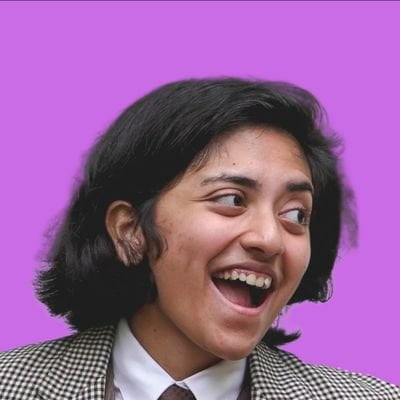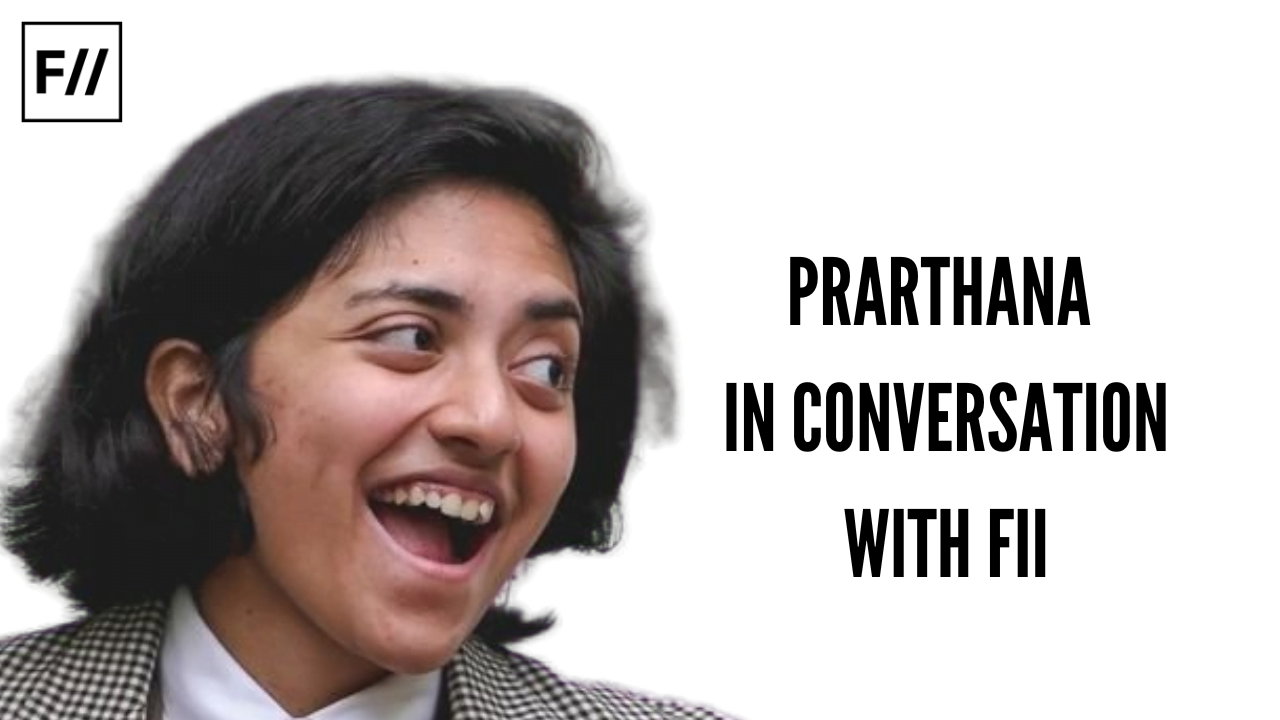Known to the public as the short haired brown Queer, Prarthana, a Bangalore based queer content creator has managed to reach thousands of hearts with her videos. Moved to action by the lack of content on the Queer community in India and the desire to produce the content that she would have liked to see, Prarthana now has 4.63K subscribers on you-tube and 15.2K followers on Instagram. While sharing her thoughts about being an Indian Lesbian, when asked to describe her work in one line, Prarthana says- “I woke up in the middle of the night with a weird gay thought and decided to break the internet”.
Q: What was your childhood like? What was it like being Queer student around such times and in a society like ours? Would having chosen some other discipline have helped in reducing the number of challenges you faced?
A: I went through most of my high school and college by being fully aware that I am a part of the LGBTQIA+ community. I knew the language for it and had access to information about it. I was never confused or or did not face any problem like not knowing how to express it in words.
“If anyone was talking about Queerness on the internet, it was usually a white person, someone from the UK or America and ended up propagating the idea that being Queer is a western concept. So, I think my intention behind making the content I produce was to fuel my own need for it.”
Prarthana
As for the discipline part, I completed my education from commerce stream and did a hotel management degree and most people around me were straight, what is more interesting was that there was no awareness about the Queer community. Most of the people I knew who identified themselves as queer were part of some humanities or arts programme, maybe it is because those disciplines deep chewed a little bit more. So, sometimes I wished that I should have gone for something that was more arts inclined, but parents were never very supportive about it.
Already I had done enough “scandalous” stuff by being openly queer.
Q: What is your focus when you make the videos? There must be some target audience in mind right? How is your content helping them? What impact does your work have?
A: I definitely aim the content to be for someone who might be struggling with something similar, those who are not able to fit in because of heteronormative norms etc. Actually, when I was 15-16, whenever I tried to google or search something like Indian Lesbian on Youtube, I never got any good results. If anyone was talking about Queerness on the internet, it was usually a white person, someone from the UK or America and ended up propagating the idea that being Queer is a western concept. So, I think my intention behind making the content I produce was to fuel my own need for it.
Also read: FII Interviews: Negha Shahin Talks About Trans Feminism And Mental Health
There are very few openly queer Indian people on the internet and even if they are, they usually don’t talk about it very much and it becomes more of a lifestyle thing. I agree it’s not like they are supposed to put out their experiences out there but if someone is looking for some familiarity or relatability, then, they offer it in a very half-hearted manner and it feels empty. But if someone can help in relating to one another, like in the form of posting stories, memes or educational information, it is done anonymously, but when I put my face there, maybe the relatability increases.

As for the feedback part, I got overwhelmingly kind feedback. I had been very closed off about my own coming out story initially, but when I put it out there, people found it relatable, they found that it is also their story. This is a very common experience and way more people than we think go through it, it’s just that due to social pressure, the story doesn’t get out.
“Adding humour in a way helps in normalising these discussions. I don’t actually know how many people are using comedy to talk about Queerness in India but I do think that a lot of Queer people use humour to alleviate the pain, isolation that they feel. That is why I think Queer meme pages are so popular, if it is light-hearted then people interact more openly. I understand that some things cannot be joked about, so, I try to ensure that I am joking about my own personal experiences and not anyone else’s or generalising it to community level.“
Prarthana
So, in terms of impact, I think it gave a lot of people the message that they are not alone and many people reached out to me saying that they were able to muster courage to come out to themselves, their friends and family. In fact, they told me that they found partners through comments. Sometimes, the impact goes right over my head, it is very fascinating, even I feel less alienated because of this. It is a give and take process.
Q: Youtube as a platform is very popular in India regardless of the age group a person belongs to. In this context, how do you see the role of Youtube in India regarding creating awareness about the Queer community?
A: I think Youtube is the best platform to post things onto. Some of my videos that can be truly considered impactful are the longer videos where I talk a bit more, share more experience. In terms of reach, Youtube reaches fewer people in contrast to Instagram which is a lot more explosive. But, impact wise, Youtube has a more concentrated impact. Like in the past 5-6 years itself Indians have started using these platforms specially Youtube very actively, making a name for themselves, pushing their content out there. And if we don’t have any Queer voices there, then, this will be forgotten for one another chance.
Q: What made you come up with this idea of starting a channel? There is generally some external influence, was there some external influence for you? What was it?
A: Surely, there was this one incident that offered me external encouragement. My best friend started a Youtube channel back when we were in college, a project that talked about social issues, feminism, mental health etc. Since I was a part of the LGBTQIA+ community, she asked me if I would be willing to do the video. That video’s still on my Youtube channel, it’s called “Being a Lesbian”.

I ended up searching Indian Lesbian on Youtube and my video featured in the top three. I was struck by the lack of content and also, the reach, relatability and the cosiness with one’s own identity that a video like that offered. It kept bothering me and finally during the Pandemic period, I started with my own channel.
Q: How do you see the role of comedy in wider societal change and awareness in India for LGBTQIA+ community? Sometimes, people say that humour-focused content reduces the seriousness of the issue, so, a balance needs to be maintained. What is your opinion about it?
A: I do think that those who are adding content about Queer community on various platforms, are very serious about it. Ranging from something as simple as what LGBTQIA+ means to something as intricate as intersectionality in being a Queer feminist etc, they have dealt with the issue seriously. So, when I myself had to explain these things to people, I did not have the literary finesse to do it, the best way I found to cope with my experiences was to joke about it and the best content that I liked was when creators joked about it.
Also read: FII Interviews: Aadi Fights Back Queerphobic-Casteist Campuses In Kerala
Adding humour in a way helps in normalising these discussions. I don’t actually know how many people are using comedy to talk about Queerness in India but I do think that a lot of Queer people use humour to alleviate the pain, isolation that they feel. That is why I think Queer meme pages are so popular, if it is light-hearted then people interact more openly. I understand that some things cannot be joked about, so, I try to ensure that I am joking about my own personal experiences and not anyone else’s or generalising it to community level. It allows a wide range of people to relate with the content, like even those out of Queer circle can relate with the funny part of it. It takes out the homophobia part of it and normalises discussion.
Q: What are the unique challenges, societal pressures or even say comments/trolls that you face being the face of Urban Queer?
A: For the first year and a half, apart from one or two odd comments, I barely received any queerphobic hate comment as such. More than being hateful, the tone was always ignorant. If I had a funny response, I used to respond back to them through videos. But I was kind of surprised, I was expecting more of such comments, that’s when I realised that my content was reaching a very niche audience, which consisted of only those who know something about the issue earlier. Recently, I made a video on debunking the idea that same-sex marriage is a western concept.
Even if people perceive that it is a western concept, then, democracy, parliament, food cuisines are also western, then, why just shut this off. I guess that was something that the general audience could relate to and that’s when I received a lot of unpleasant comments, personal attacks, swear words etc. that was clearly in violation with Instagram’s norms and I did have a hard time dealing with it as I quite struggle with my temper at times. I did not know how to deal with them, how to have a logical argument with someone who doesn’t care about you as a person. Then, I thought at least they are giving me engagement, I ended up reporting a lot of pages on Instagram, but, I don’t think that works. I was quite let down by the platform that I was on. Eventually, it died down but it was an experience as it made me realise that till then I was reaching out to a very niche audience.
Q: Where do you wish to take your initiative further? What’s the future vision?
A: My intention of producing this content was because I wanted to create it and I had fun doing it. That is why I have said no to the majority of monetary collaborations. I would ask them, “Have you hired any LGBTQIA+ person and they are like, we are open to everyone but no one has come to us.” And I always felt like telling, you know you have to put in a bit of an effort.
Also read: Gazal Dhaliwal: “I Always Knew, I Was A Woman” | FII Interviews
So, I don’t see that as a future of what I wish to do. Apart from continuing what I am doing right now, I really want to use my reach to have some events currently in Bangalore and later expand to other places. I wish to create offline spaces where people who feel like they are lonely, or do not know how to find people or romantic interests can be helped out.

Also, I wish to make a series where my experiences take the backseat and talk to other Queer people who are in a particular professional space like marketing, law, journalism and ask them about their experiences. This is so that younger Queer folks know that they can grow up to be whatever they wish to be and there’s always some way to make everything work out.
FII thanks Prarthana for her time and illuminating insights into her work. You can follow her on Instagram.
About the author(s)
Arya is an undergraduate student pursuing an Integrated Master's in Development Studies from the Indian Institute of Technology, Chennai. She completed her schooling in the humanities stream from Nagpur. Still hooked to teenage novels, she likes singing, dancing and loves talking. Intersectionality became her favourite word since the time she was introduced to it. Her major interests include adopting the intersectional feminist approach in studying other disciplines like Economics, Management, Development and interpretation of literature, films Etc.





